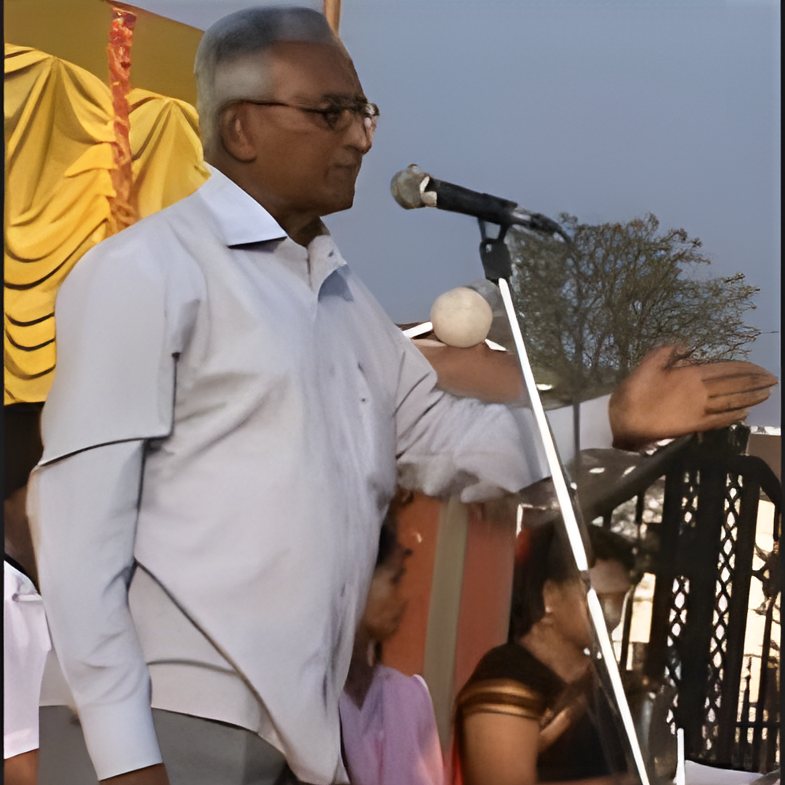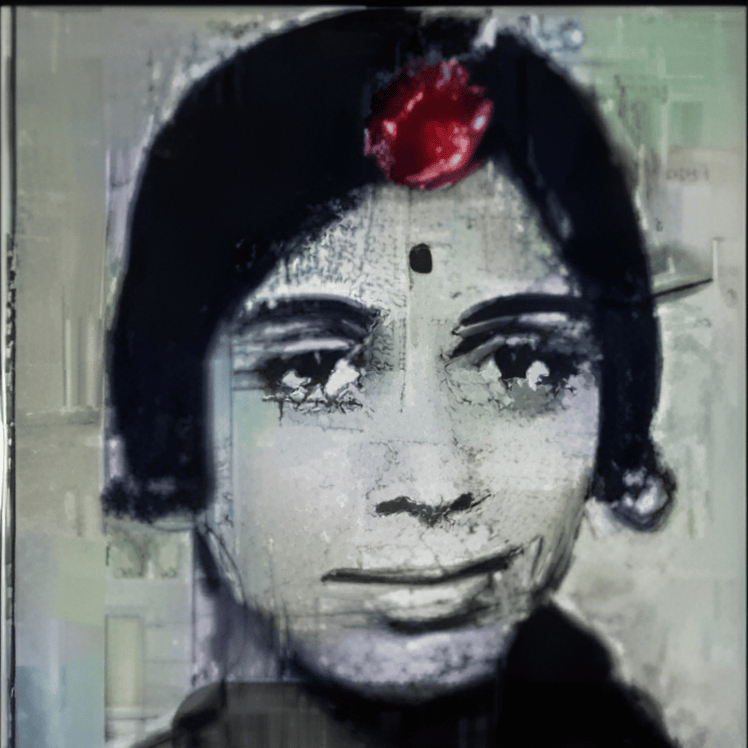By Srinivas Rayappa
Content warning: This article contains descriptions of violence, murder, and investigative details that readers may find disturbing.
Dr. B.R. Harale’s weathered hands tremble slightly as he speaks at yet another protest meeting, his 76-year-old voice breaking when he sees the photograph of 17-year-old Soujanya—the young woman whose story we explored in our first article “The Shadow of Dharmasthala: Unraveling the Soujanya Case”. The elderly doctor, with 51 years of medical service behind him and 17 years of treating patients without charge, recognizes something achingly familiar in that innocent face. It is the same courage, the same defiant spirit, the same tragic destiny that he witnessed in his own wife, Vedavalli, in 1979.
The Woman Who Wouldn’t Be Silenced
For Dr. Harale, the “Justice for Soujanya” campaign is more than activism—it is a mirror reflecting his own decades-long struggle for truth. In his public testimonies, delivered in half-hour speeches before crowds in open grounds, he has detailed a story that begins not with his wife’s death, but with her life—a life dedicated to education, justice, and the radical belief that merit should matter more than caste.
A Love Born of Service
In 1965, when Vedavalli married Dr. B.R. Harale, both were united by a shared commitment to serving their community. Dr. Harale, a Government Doctor, had been posted to Dharmasthala for rural service, an assignment he cherished. Here was a chance to heal the sick in a place where temples and medicine could work hand in hand for the greater good.
As Dr. Harale has recounted in his public speeches, Vedavalli brought remarkable credentials to their partnership. In an era when few women in Dakshina Kannada received higher education, she held both a BSc and BEd degree—qualifications that marked her as exceptional in the 1970s. By the late 1970s, she had established herself as a respected educator at one of the SDM educational institutions in Dharmasthala, part of a network that had been established in 1966 and was rapidly gaining prominence throughout Karnataka.
Together, they built a family anchored in service and principle. Their son would follow his father’s path into medicine, eventually completing his MD. Their daughter would inherit her mother’s fighting spirit. The children studied in Panambur, an industrial area where many families sent their children for better educational opportunities.
According to Dr. Harale’s testimony, Vedavalli was not just any teacher. Her students respected her, her colleagues admired her, and everyone who worked with her knew her worth. All her colleagues would discuss among themselves that she would surely be the next Headmistress of the school.
But merit alone was never enough.
The Promotion That Never Came
The year was 1975-76 when the position of Headmistress became available. In his public accounts, Dr. Harale has detailed how, by every measure of fairness and qualification, the role should have gone to Vedavalli. She had served faithfully at the educational institution, demonstrating competence and earning trust throughout the community.
But there was another teacher—a junior from another society in Ujire—who also wanted the same post. As Dr. Harale has publicly stated, this teacher lacked Vedavalli’s qualifications and experience but possessed something more valuable in the power structure: the right caste connections. According to his testimony, the decision was caste-based—Vedavalli was a Lingayat, while the junior teacher belonged to the same caste as the school administration’s leadership.
Instead of following merit, the institution’s management chose caste loyalty. The junior teacher was appointed Headmistress.
For most people, this would have been a bitter disappointment to be swallowed in silence. But Vedavalli was not most people.
The First Stand
In Dr. Harale’s account, Vedavalli stood in front of the very school where she had dedicated years of her life and protested to stop caste bias. Her colleagues watched in a mixture of admiration and fear as she made her objection known publicly—an act of defiance virtually unheard of for a woman in 1970s India.
The institution’s response, according to Dr. Harale’s testimony, was swift and harsh—she was intimidated and evicted from the premises. The message was clear: know your place, accept your fate, and be grateful for what you’re given.
But Vedavalli did not stay silent. If the institution would not listen to reason, she would seek justice through the law.
The Legal Battle
When intimidation failed to silence her, Dr. Harale recounts, Vedavalli took the step that would ultimately cost her life: she challenged the decision in court through a prominent lawyer, U.R. Kini from Mangalore. Ironically, according to local accounts from that period, Kini allegedly also represented the temple administration among his clients, but professional ethics ensured that Vedavalli received proper legal representation.
In his public speeches, Dr. Harale has shared how throughout the legal battle, Vedavalli’s resolve never wavered. She would tell her husband, “I don’t care if they don’t promote me as Headmistress, but they should at least respect and adhere to the Law of the land.” For her, this was not about personal ambition—it was about the principle that merit should triumph over influence.
According to Dr. Harale’s testimony, Vedavalli achieved a legal victory in her case, though court records from that period are difficult to access today, as many historical documents from 1979 may not have been preserved in easily accessible formats. In his public accounts, he describes how people whispered about the woman who had taken on the powerful and won.
But power does not take defeat lightly.
The Price of Victory
Dr. Harale has publicly detailed how, following his wife’s court victory, they faced escalating retaliation. In his testimony, he describes how they decided to take their protest public in 1978, demonstrating in front of the Dharmasthala temple gate.
According to his account, the response was swift and violent. Two lorries loaded with people arrived at the protest site. What followed was not discussion but a coordinated attack. In Dr. Harale’s words, Vedavalli fell to the ground, tears streaming down her face from the physical assault, but even then, her spirit remained unbroken. Through her tears, she kept repeating words that would prove prophetic: she would continue her protests even at the cost of her life.
Dr. Harale has testified that following this attack, K. Vasanth Bangera, Former Member of the Karnataka Legislative Assembly, came to their rescue. His intervention likely saved them from worse harm, but as Dr. Harale recounts, it also marked them as troublemakers. According to Dr. Harale’s account, the institution then sent a suspension order to Vedavalli, which he believes was connected to her association with the political figure who had helped them.
The Campaign of Terror
In his public testimony, Dr. Harale has detailed the systematic harassment that followed. The couple began receiving threats, he states, with unknown miscreants arriving at their home under cover of darkness, pelting stones at their house while the family cowered inside. Night after night, according to his account, the sound of stones served as a constant reminder that they were being watched.
Dr. Harale has shared how, returning home each evening from his medical duties, he wondered whether stones would give way to something worse. The couple had planned simple family visits to see their children in Panambur, but even these innocent plans were overshadowed by mounting threats.
Those words Vedavalli had spoken—”even at the cost of her life”—would haunt Dr. Harale forever, because they turned out to be more than determination. They were prophecy.
April 4th, 1979: The Day Justice Died
In his public speeches, Dr. Harale has provided detailed testimony about the day his wife was murdered. The systematic intimidation had failed to silence Vedavalli, he recounts, so they killed her.
According to Dr. Harale’s account, he had been called away to attend a function at the Taluk Board Hospital on April 4th, 1979. The couple had planned to travel together to Panambur after his return to visit their children. When he returned from the function that afternoon, he discovered what he describes as a scene from hell.
In his testimony, Dr. Harale details how Vedavalli had been raped and then murdered—burnt alive in the bathroom of their house using kerosene. As a trained physician, he states, he collapsed to the ground upon seeing his wife’s body, but his medical knowledge made it immediately clear that this was no accident or suicide.
Dr. Harale has publicly testified about the postmortem evidence: Vedavalli had suffered third-degree burns, a fractured neck and fractured elbow. The cement below her hips and shoulders had peeled off, evidence of violent struggle. The position of her body, he states, didn’t indicate suicide. As he has asked in his public speeches: Why would a lady who had fought against caste bias and for her rights even consider suicide?
According to witness accounts referenced in recent investigative reports, allegations point to Narayan Kamath, described as “a person linked to the powerful network around Dharmasthala,” though it should be noted that he was never formally charged by police, and these remain allegations.
The Ultimate Betrayal
Dr. Harale has provided detailed public testimony about what happened when he sought justice. Instead of investigating the obvious evidence of murder, he recounts, the police chose a different path. Superintendent of Police Ramesh declared her murder a suicide, despite all evidence to the contrary.

In his public account, Dr. Harale describes how the police framed him as the accused in his own wife’s murder. His frequent visits to the police station, repeatedly insisting that his wife was murdered and couldn’t have committed suicide, led the police to frame him to discourage his persistence, he has testified.
According to Dr. Harale’s public statements, he fought the case in court, eventually submitting evidence proving his innocence and securing his release. But as he has shared in his speeches, the damage was done. His wife was murdered, his name dragged through mud, his children traumatized, his faith in justice shattered. And the real perpetrators, he states, have been roaming free throughout.
A Life Rebuilt on Healing
Dr. Harale has publicly shared how he chose service over bitterness. For 51 years, he served as a doctor. After retirement, he has continued treating patients free of cost for 17 years, often spending from his monthly pension of Rs. 25,000 to help those who cannot afford medicine. With his medical expertise spanning cancer, nephrology, and psychiatric care, the man who was framed for murder became known for compassion.
Remarkably, as Dr. Harale has testified, despite facing constant threats after his wife’s murder, he never applied for a gun license. Instead, he carried cyanide, threatening attackers by showing it and explaining its lethality. He preferred cyanide over a gun, he has stated, because it could affect multiple people at once—and he was mostly attacked by groups rather than individuals.
But the trauma never left him. In his public testimony connecting his wife’s 1979 murder to the 2012 case we explored in “The Shadow of Dharmasthala: Unraveling the Soujanya Case”, he breaks down when he sees Soujanya’s innocent face. In recent years, he has said that “he had remained quiet for the future of his children” but that “God has awakened those who have been victims of injustice.”
The Children’s Burden and the Pattern Established
Today, Dr. Harale’s children embody different responses to injustice. Their son, now a doctor with an MD, believes protesting makes no sense—justice has been denied so long that further struggle seems futile. He often says, as Dr. Harale has shared, “These people are so powerful, that they can buy anything in the world because they have surplus money.” He has chosen to honor his parents through professional achievement and quiet service.
Their daughter, however, has inherited something of her mother’s fighting spirit. She believes the protests must continue, that Vedavalli’s memory demands ongoing struggle for truth and accountability. She understands that giving up means letting the system win completely, allowing other families to suffer what theirs has endured.
What happened to Vedavalli Harale in 1979 established a template used repeatedly in the decades that followed. The tactics—professional retaliation, escalating intimidation, public violence, psychological warfare, murder when other methods failed, police cover-up, and institutional amnesia—would become standard procedure for dealing with those who dared challenge authority in the region.
As we explored in “The Shadow of Dharmasthala: Unraveling the Soujanya Case”, these same tactics would be employed against Soujanya’s family 33 years later. The methods were refined, the network more sophisticated, but the underlying pattern remained unchanged.
The Shadow That Started It All
Vedavalli Harale believed in merit, trusted in justice, thought the law would protect her right to fair treatment. Her story reveals the moment when the shadow of Dharmasthala first showed its true nature—that challenging institutional power was potentially fatal, that the network of influence would use any means to maintain control, that police would protect the powerful rather than seek truth.
Dr. Harale understood what others were only beginning to see: that his wife’s murder in 1979 was not an ending, but a beginning. That the shadow cast by her death would stretch across decades, touching other families, claiming other daughters.
Even now, at 76, he continues speaking out, his voice carrying decades of injustice, his 96-year-old mother a living witness to their struggle. When he speaks at public meetings alongside other grieving families, he embodies transformation from victim to advocate—a man who “remained quiet for the future of his children” but whom “God has awakened” to speak for the silenced.
In our next article, we will explore how this shadow continued to spread through the decades, when medical student Ananya Bhat would discover that even pursuing education in this region could prove deadly for those who asked the wrong questions or found themselves in the wrong place at the wrong time.
We remember Vedavalli Harale—the teacher who went to court to claim her rightful promotion, who declared she would continue fighting even at the cost of her life, who was burnt alive for believing that merit should matter more than caste. She lost her battle, but won the right to be remembered as the woman who first showed us the true face of power in Dharmasthala, lighting a flame that continues to burn in the hearts of those who refuse to accept that justice is only for the powerful.
Note: This article is based primarily on the extensive public testimony of Dr. B.R. Harale, delivered in public speeches over many years, supplemented by investigative reports, historical accounts, and documented witness testimonies from the period. While some specific details remain disputed due to the passage of time and limited availability of official records from 1979, Dr. Harale’s firsthand account as the victim’s husband provides the foundation for this historical documentation. The article presents these accounts as they have been publicly stated, acknowledging that multiple perspectives may exist on disputed events.


